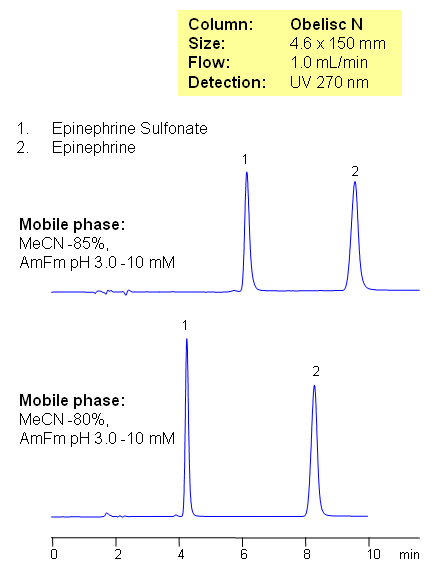
Epinephrine (also referred to as adrenaline) is a hormone and neurotransmitter. It is a catecholamine, a sympathomimetic monoamine derived from the amino acids phenylalanine and tyrosine. This method can be used to determine and quantitate epinephrine and epinephrine sulfonate in biological fluids (urine, blood, serum) and drug formulations. Obelisc N columns are used to retain and separate epinephrine and epinephrine sulfonate in mixed-mode hydrophilic interaction chromatography. Epinephrine is retained by the combination of cation-exchange and HILIC mechanisms. Epinephrine sulfonate is retained by HILIC mechanism. Buffer concentration and pH, as well as the amount of acetonitrile, can be used to adjust retention of both compounds. Both compounds can be detected by UV, ELSD and LC/MS. Preparative separation is possible with volatile mobile phases (ammonium formate or ammonium acetate.
| Column | Obelisc N, 4.6×150 mm, 5 µm, 100A |
| Mobile Phase | MeCN/H2O |
| Buffer | AmFm pH 3.0 |
| Flow Rate | 1.0 ml/min |
| Detection | UV, 270 nm |
| Class of Compounds |
Drug, Hydrophilic, Ionizable, Vitamin, Supplements |
| Analyzing Compounds | Epinephrine, Epinephrine Sulfonate |
Application Column
Obelisc N
SIELC has developed the Obelisc™ columns, which are mixed-mode and utilize Liquid Separation Cell technology (LiSC™). These cost-effective columns are the first of their kind to be commercially available and can replace multiple HPLC columns, including reversed-phase (RP), AQ-type reversed-phase, polar-embedded group RP columns, normal-phase, cation-exchange, anion-exchange, ion-exclusion, and HILIC (Hydrophilic Interaction Liquid Chromatography) columns. By controlling just three orthogonal method parameters - buffer concentration, buffer pH, and organic modifier concentration - users can adjust the column properties with pinpoint precision to separate complex mixtures.
Select optionsEpinephrine Sulfonate





